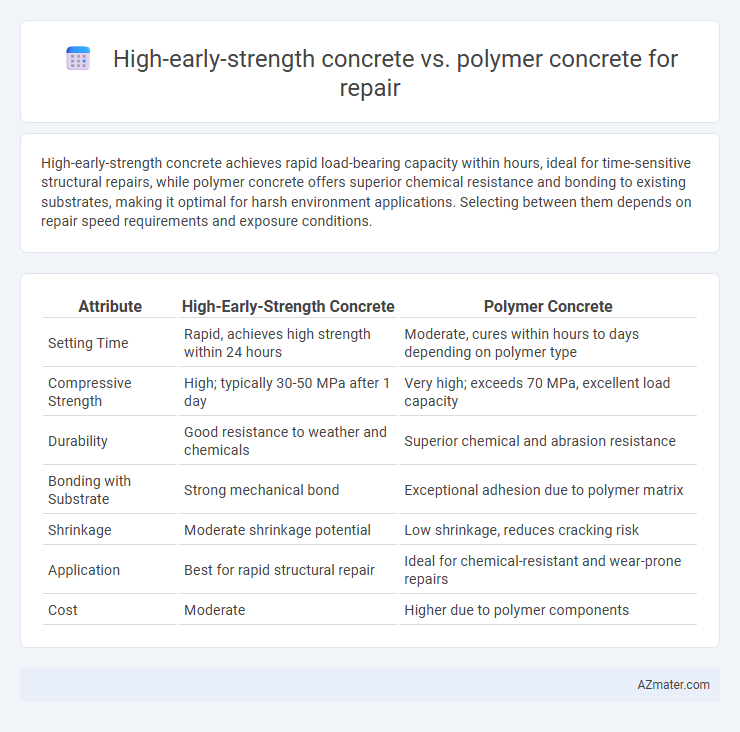High-early-strength concrete achieves rapid load-bearing capacity within hours, ideal for time-sensitive structural repairs, while polymer concrete offers superior chemical resistance and bonding to existing substrates, making it optimal for harsh environment applications. Selecting between them depends on repair speed requirements and exposure conditions.
Table of Comparison
| Attribute | High-Early-Strength Concrete | Polymer Concrete |
|---|---|---|
| Setting Time | Rapid, achieves high strength within 24 hours | Moderate, cures within hours to days depending on polymer type |
| Compressive Strength | High; typically 30-50 MPa after 1 day | Very high; exceeds 70 MPa, excellent load capacity |
| Durability | Good resistance to weather and chemicals | Superior chemical and abrasion resistance |
| Bonding with Substrate | Strong mechanical bond | Exceptional adhesion due to polymer matrix |
| Shrinkage | Moderate shrinkage potential | Low shrinkage, reduces cracking risk |
| Application | Best for rapid structural repair | Ideal for chemical-resistant and wear-prone repairs |
| Cost | Moderate | Higher due to polymer components |
Introduction to High-Early-Strength Concrete and Polymer Concrete
High-early-strength concrete achieves rapid strength gain within hours, making it ideal for fast-track repairs and minimizing downtime in infrastructure projects. Polymer concrete incorporates polymeric resins instead of traditional cement, offering superior chemical resistance, enhanced durability, and excellent bonding properties for repairing corrosive or high-stress environments. Both materials address specific repair needs: high-early-strength concrete excels in rapid load-bearing recovery, while polymer concrete provides long-term resilience against environmental degradation.
Key Material Properties Comparison
High-early-strength concrete achieves rapid strength gain through accelerated hydration of Portland cement, offering compressive strengths typically above 20 MPa within 24 hours, making it ideal for fast-track repairs. Polymer concrete incorporates organic polymers as a binder, providing superior tensile strength, chemical resistance, and low permeability compared to traditional cementitious materials. Key material differences include high-early-strength concrete's brittleness and lower chemical durability versus polymer concrete's enhanced adhesion, flexural strength, and resistance to freeze-thaw cycles and aggressive chemicals.
Setting Time and Curing Requirements
High-early-strength concrete typically achieves initial set within 1 to 3 hours and reaches substantial strength in 24 hours, enabling faster repairs with shorter curing durations that often require moist curing for 1 to 3 days. Polymer concrete, composed of resin binders like epoxy, sets rapidly within minutes to hours and cures at ambient temperatures without the need for prolonged moisture curing, offering superior chemical resistance and adhesion for structural repair. Selecting between these depends on the repair timeline, exposure conditions, and required mechanical properties, with high-early-strength concrete favored for load-bearing repairs needing quick strength gain and polymer concrete preferred for chemical resilience and minimal downtime.
Strength Development and Performance
High-early-strength concrete achieves rapid compressive strength within 24 to 72 hours, reaching up to 20-40 MPa, making it ideal for fast-track repairs requiring early load-bearing capacity. Polymer concrete, enhanced with resins such as epoxy or polyester, offers superior chemical resistance, tensile strength, and durability, though its strength development may take longer and depends on curing conditions. For structural repair, high-early-strength concrete excels in quick turnaround situations, while polymer concrete provides enhanced long-term performance in aggressive environments.
Durability in Harsh Environments
High-early-strength concrete offers rapid strength gain, enabling faster repairs but may experience microcracking under harsh environmental conditions, compromising long-term durability. Polymer concrete exhibits superior chemical resistance, reduced permeability, and enhanced adhesion, making it ideal for repairing structures exposed to aggressive chemicals and freeze-thaw cycles. Durability in harsh environments favors polymer concrete due to its ability to withstand chemical attack and physical degradation better than traditional high-early-strength concrete.
Adhesion to Existing Substrates
High-early-strength concrete offers rapid setting and gaining strength, ensuring efficient load transfer when bonding to existing substrates, but its adhesion largely depends on surface preparation and moisture conditions. Polymer concrete provides superior adhesion properties due to its resin content, creating a strong chemical bond with diverse substrate materials, minimizing issues like delamination and shrinkage cracks. For repair projects requiring durable and flexible bonding, polymer concrete often outperforms high-early-strength concrete in maintaining long-term substrate integrity.
Application Methods and Workability
High-early-strength concrete offers rapid setting and high early load-bearing capacity, making it ideal for time-sensitive repairs with conventional pouring or pumping methods. Polymer concrete uses resin binders providing superior adhesion and chemical resistance, applied mainly through casting, troweling, or spraying for precise repairs. Workability in high-early-strength concrete relies on optimized water content for flow, while polymer concrete demands careful resin-to-filler ratios for consistency and ease of application.
Cost Considerations and Economic Analysis
High-early-strength concrete offers lower initial material costs and faster curing times, reducing labor expenses and downtime during repair projects, making it economically advantageous for time-sensitive applications. Polymer concrete, despite higher upfront material costs, provides superior chemical resistance and durability, leading to lower long-term maintenance and repair expenses. Economic analysis shows that selecting between these concretes depends on balancing initial investment with lifecycle cost savings based on project-specific environmental conditions and performance requirements.
Typical Repair Scenarios and Suitability
High-early-strength concrete is ideal for rapid structural repairs like bridge decks and pavements where quick load-bearing capacity restores functionality promptly. Polymer concrete excels in chemical-resistant repairs and patching in aggressive environments such as sewage treatment plants or industrial floors. Both materials offer fast curing times, but polymer concrete's superior adhesion and durability make it preferable for small, intricate repairs requiring enhanced resistance to moisture and chemicals.
Choosing the Right Concrete for Your Repair Project
High-early-strength concrete offers rapid curing and high compressive strength within hours, ideal for time-sensitive structural repairs requiring immediate load-bearing capacity. Polymer concrete provides superior chemical resistance and adhesion to diverse substrates, making it suitable for repairs exposed to aggressive environments or requiring long-term durability. Selecting the right concrete depends on project-specific factors such as curing time, environmental exposure, and mechanical performance needs.

Infographic: High-early-strength concrete vs Polymer concrete for Repair
 azmater.com
azmater.com